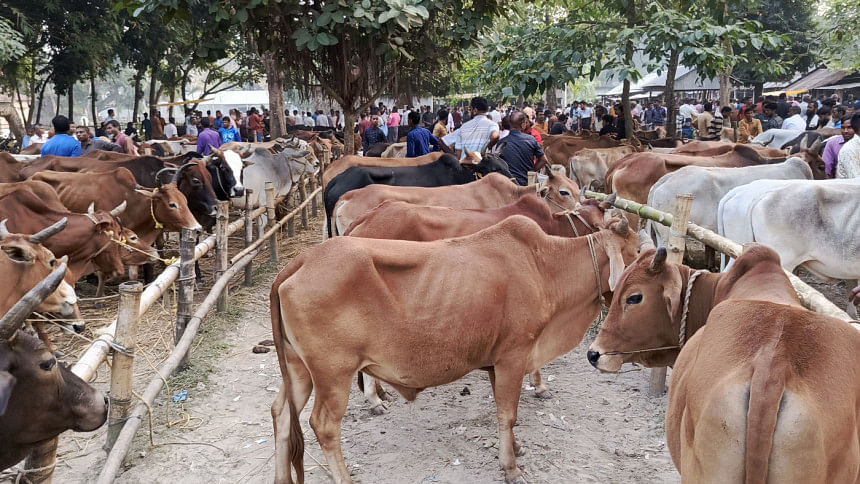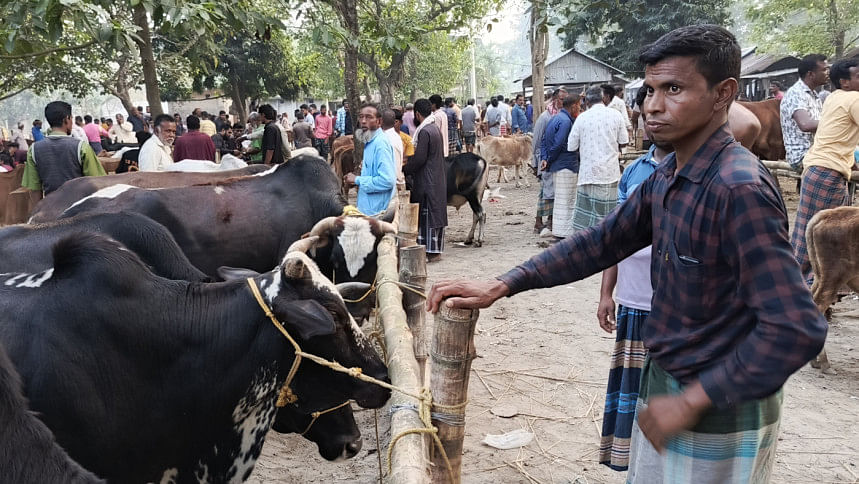Eid brings hope for cattle farmers in Rangpur

With Eid-ul-Azha approaching, cattle farmers in Rangpur division are optimistic about securing fair prices for their sacrificial animals, thanks to the absence of Indian cattle in local markets this year.
With increased local supply and no foreign cattle expected, many farmers are hopeful that this year's Eid will bring better profits and long-awaited relief.
Last year, an influx of Indian cattle led to a significant drop in local market prices, leaving many farmers disappointed. This year, the situation appears more favourable, as the markets are filled with locally reared cows, goats, buffaloes, sheep, and a few dumba (fat-tailed sheep), awaiting buyers.

According to the Department of Livestock, around 19,98,000 sacrificial animals have been prepared across the eight districts of Rangpur division, while the estimated demand stands at 14,12,000. This means there is a surplus of about 5,68,000 animals, which could be supplied to other regions of the country.
The demand for Rangpur is 2,24,752 animals, 1,26,305 for Gaibandha, 2,22,840 for Kurigram, 2,23,166 for Nilphamari, 1,71,777 for Lalmonirhat, 2,63,646 for Dinajpur, 75,361 for Thakurgaon, and 1,04,300 animals for Panchagarh.
Although formal sacrificial animal markets (haats) are yet to be set up for Eid, trading has already begun in many areas. Farmers are preparing their animals and expect to fetch Tk 10,000–15,000 more per cow and Tk 2,000–3,000 more per goat compared to last year.
Local farmers, however, have voiced concern over the rising cost of animal feed. Both green grass and grain-based feed have become increasingly expensive, making livestock farming a financial burden. This, they say, will likely lead to higher prices for sacrificial animals in the market.
Sirajul Islam, a 55-year-old farmer from Durakuti village in Lalmonirhat Sadar, said, "Last year, I sold three cows for Tk 1,65,000 but expected around Tk 1,80,000 to 1,90,000. The presence of Indian cattle drove prices down. This year, I have four cows ready and hope to sell each for Tk 65,000 to 70,000."
Julhas Hossain, 50, a cattle farmer from Jatrapur village in Kurigram Sadar, said, "We suffered losses last year due to the huge number of Indian cattle. This year, I've prepared eight cows and expect a better return, though feed costs have risen significantly."
Latifur Rahman, president of the Rangpur Dairy Farmers' Association, said there is no need to import cattle from outside the country. "The Rangpur division has sufficient cows and goats to meet local demand. In fact, we can supply the surplus to other parts of the country," he said.
Dr Abdul Hai Sarkar, divisional director of the Department of Livestock in Rangpur, confirmed that no cattle are expected to enter from neighbouring countries this year. "Border Guard Bangladesh (BGB) has tightened surveillance to prevent illegal cattle smuggling," he said.
"A total of 295 temporary and permanent haats will be set up across the eight districts of the division for sacrificial animal trading."

 For all latest news, follow The Daily Star's Google News channel.
For all latest news, follow The Daily Star's Google News channel. 



Comments